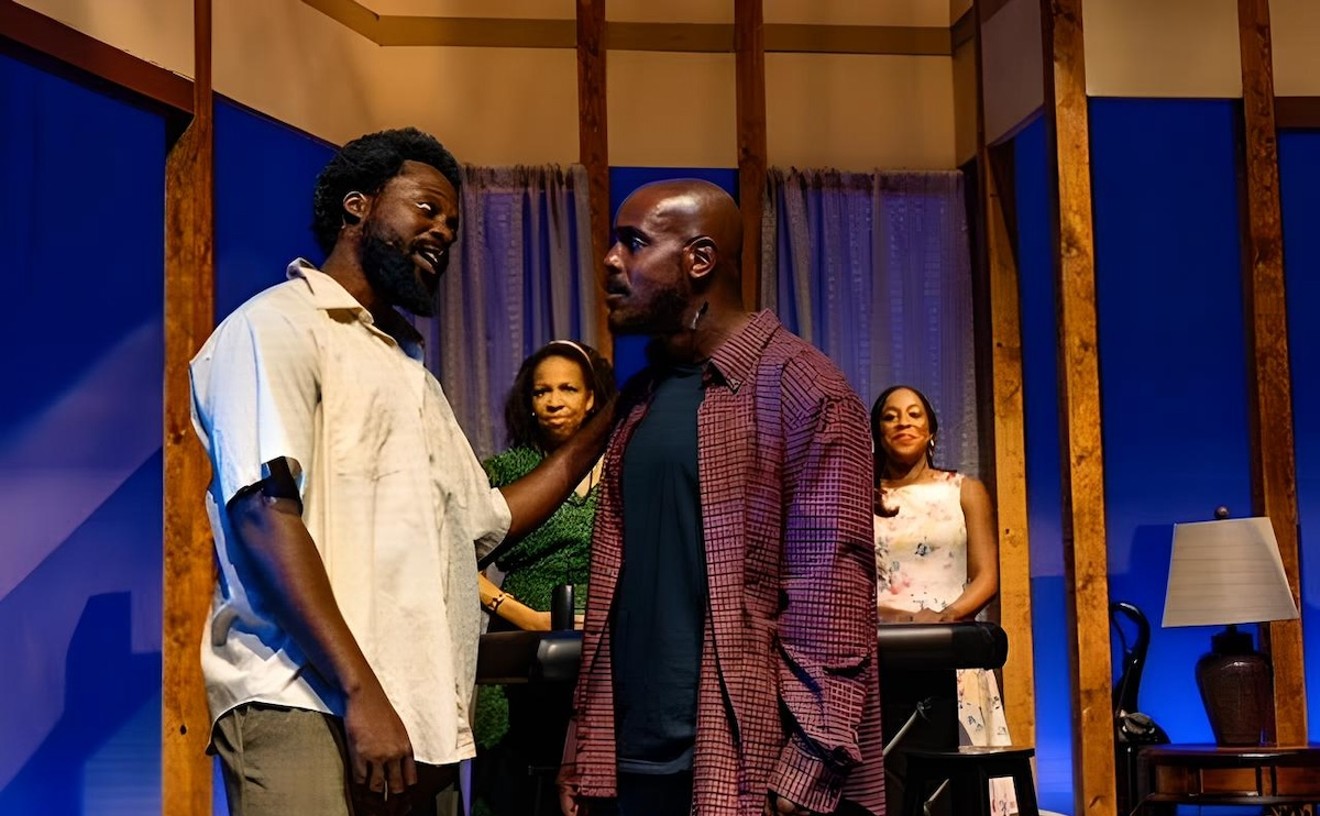These staged little scenes, imaginary landscapes, and sculpted animals are all coated with pulverized paper money, as if shrouded in some kind of green fur. I can't help thinking of a Shakespeare quote in Das Kapital where Marx defines money as commodity of commodities: "This yellow slave will knit and break religions; bless the accursed ... place thieves and give them title, knee, and approbation. Thou common whore of mankind."
"Social Fabric" is Trasobares's latest commentary on consumption, institutional excess, Cuban politics, and sexual appetite. An artist, curator, collector, and art activist, Trasobares has worked in Miami for three decades. He's shown here and elsewhere and his output has remained constant. Yet Trasobares is not as well-known as he should be and his own artistic independence may have to do with it. He prefers to keep art separated from business to be free to engage in social discourse.
His mix of tension and sarcasm resembles Marcel Broodthaers's appraisals of the art market. Broodthaers, the late Belgian conceptual artist, created -- like Trasobares -- conspicuous museumlike displays. In addition a "surrealist" Cuban-exile touch can be discerned in Trasobares's critique. "Social Fabric" is a protest, a paradox, a slip-of-tongue, a combination of Pop and satire.
We're not to follow the advice of financial analysts when it comes to money. Instead Trasobares tells us to "soak dollars into rum to address and motivate [the orisha god] Elegguá ... to mark dollars with cause and slogan to address its official presence, to sprinkle dollars with talcum powder," or to "use dollars as prop in stage and fold bills like chewing gum sticks for service tips."
And there's great pleasure in Trasobares's meshing of image and title. So-Be Bonsai Tree is a miniature Japanese garden with little wiry trees coming out of liquor tumblers. The piece makes me ponder the life of leisure atop those unattractive, oversized apartments in Miami Beach, out of the reach of most people. The catlike little sculpture with shredded currency as fur entitled Tigre is a double-entendre for a sexual predator. Or Caballo Verde (Green Horse), which like Tigre literally conveys what it shows -- a horselike sculpture made of paper money -- but the Cuban slang brings thoughts of exile politics (Castro is called "El Caballo") and lust as secondary meaning.
What do Trasobares's shredded currency and animal appetites have in common? Playing with paper money alters the idea of capitalist exchange, and debases its value, stripping away any high-culture shine on capitalism and making greed and conspicuous consumption simply a basic instinct. "Social Fabric" comes with a Xeroxed catalogue, a samizdat publication very much in tune with the exhibit's seditious mood. The essay, written by Joel Weinstein, is a fine piece.
Take an imaginary voyage into a realm of colorful thorns, pistils, seeds, and flowers with Mario Bencomo's "Wanderlust," his solo show at Elite Fine Arts.
Firstly about the smooth surface, sans texture. Sometimes such amassed textures, meant to enhance the image, simply become a crutch for eloquence. In Bencomo's work the canvas's surface is a background vehicle to let color express itself. And he wants you to contemplate it without intense comparison: Is there a sense of "purple" in an "all-purple" realm (and believe me, Bencomo is keen on purple)?
Being highly sensorial and rich, color in painting is a maker of illusions. To better acquaint myself with Bencomo's work, I revisited questions asked by the philosopher Ludwig Wittgenstein in his Remarks on Color: How far is purplish-blue from bluish-purple? Is purple successful next to red, without it being close to yellowish-green? To answer the question see Bencomo's Esther's Journey.
This art belongs within the still-life tradition, which goes back to stilleven, a Dutch style with a twofold course: one fascinated with botany and inspection, the other didactic but highly sensual. The Dutch learned that plants and fruits reveal -- if properly arranged and categorized -- valuable lessons about life and death. For instance hard fruits like citrus evoke sexuality; ripened fruits with their first marks of decay suggest death; a fruit's skin can actually be viewed more like clothing (no wonder half-peeled lemons often appeared in depictions of brothels).
But Bencomo's work is not still life per se. He leaves the old narrative of apples-and-jug-and-plate behind to fabricate sensually abstract explorations. The subject matter is brought closer and one cannot make out anything outside it.
Bencomo's Ambulus, Adoratus, and Reditus have an assortment of forms that breathe in and out amid flashes of contrasting hues. The eye follows a curvilinear motion inside this profusion of seed clusters, the parade of reddish petals with yellow crowns, and bluish oval bouquets shielded by purple pointy stems adjacent to reddish furry spikes.
Works like Fluviala, Different Paths, and Nocturnas, on the other hand, are too messy. They have too many things fighting for attention and their form remains ornamental. I prefer when Bencomo takes risks by opening up spaces to provoke color tensions, like in Versus, a poetic piece with only two juxtaposed elements: stem and flower. Not an easy task to keep such sparsity within a style that depends so much on the form's sensuality.
Another piece that arose last Basel month is Mette Tommerup's installation inside the stainless-steel gazebo in front of the Wolfsonian Museum on Miami Beach. The Ho Chi Minh monument in Hanoi inspired Trampoline, a pink-lit chamber containing an Arabic pipe, car air fresheners, red poppies, medallions of digitized images of opium dens, and a suspended male mannequin.
The piece is a wonderful joke, a surreal vision of kitsch political embalming bordering on fetishism. A displayed critique next to Tommerup's piece describes the installation as "aggrandizing memorials for political figures" and a "transcendent portrait of human experience." In addition to Trampoline itself, Tommerup's other prank is to provide us with a review worthy of a government-controlled Hanoi newspaper.










